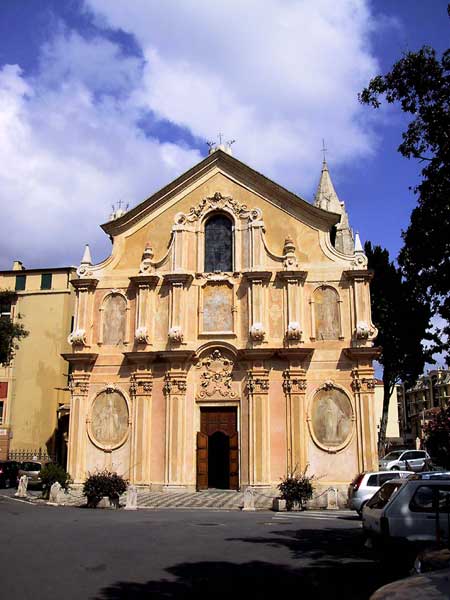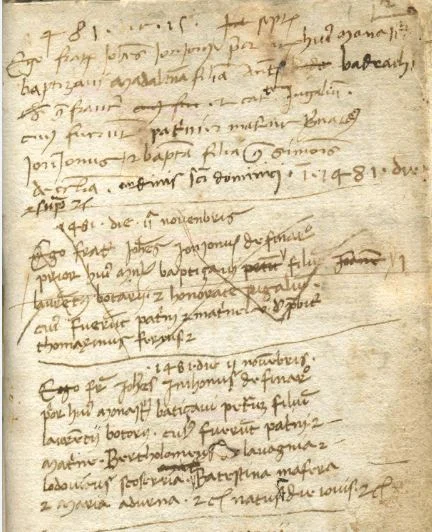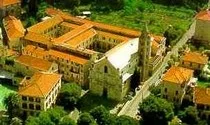parish church
Abbey
THE ANCIENT CHURCH PIA
The motto " Pia " which , as an adjective in our devonotinal language instinctively applied to Mary , in its origin did not have this value . It derived from the name of the territory and referred to the "Valley Pia " flower along the course of the current Sciusa . This name began to appear , with its change of Picis , Pice , Pingue , Pia in documents of the eleventh and twelfth centuries , and always indicates a country organized as a free " company " or structure of group with its own disciplinary and social rules.Significant for scholars is the combination of the Castrum Perti and Castrum Piæ : the first was to be a defensive fortress of the territory of the Finale to the inner part of the territory , while the Castrum Piæ was to be a defensive center of the maritime area . The name of Finalpia must be sought in the historical events shared by the three towns of Finale Marina , Borgo and Pia
with its change of Picis , Pice , Pingue , Pia in documents of the eleventh and twelfth centuries , and always indicates a country organized as a free " company " or structure of group with its own disciplinary and social rules.Significant for scholars is the combination of the Castrum Perti and Castrum Piæ : the first was to be a defensive fortress of the territory of the Finale to the inner part of the territory , while the Castrum Piæ was to be a defensive center of the maritime area . The name of Finalpia must be sought in the historical events shared by the three towns of Finale Marina , Borgo and Pia
 with its change of Picis , Pice , Pingue , Pia in documents of the eleventh and twelfth centuries , and always indicates a country organized as a free " company " or structure of group with its own disciplinary and social rules.Significant for scholars is the combination of the Castrum Perti and Castrum Piæ : the first was to be a defensive fortress of the territory of the Finale to the inner part of the territory , while the Castrum Piæ was to be a defensive center of the maritime area . The name of Finalpia must be sought in the historical events shared by the three towns of Finale Marina , Borgo and Pia
with its change of Picis , Pice , Pingue , Pia in documents of the eleventh and twelfth centuries , and always indicates a country organized as a free " company " or structure of group with its own disciplinary and social rules.Significant for scholars is the combination of the Castrum Perti and Castrum Piæ : the first was to be a defensive fortress of the territory of the Finale to the inner part of the territory , while the Castrum Piæ was to be a defensive center of the maritime area . The name of Finalpia must be sought in the historical events shared by the three towns of Finale Marina , Borgo and Pia .Because of the passage of the country 's Pia to feudal rule of the Del Carretto , in the person of Henry II( +1239 ) , they joined the territory of Finale to the Marquis of Savona , the village of Pia , as others in the area, could not became a free common although this union helped to preserve the region of Finale a significant political and administrative units . In each case subsequent documents continue to provide extensive guidance about the town of Pia which they designate with different expressions , indices in turn to an increase in interest and vitality of true Finarii Pie , Pie de Monte , Pia de , de Pia is districtus Finarii , de Finario vallis Pie , Pie in poxe Finarii Vallis . Nor lacking some expression indicating more clearly a fraction at the beach , Burgum Maris or maritima Finarii prope vallem Pie The origin of the Sanctuary of Maria Pia is likely to be placed in line with what happened at the end of the first millennium for castrum Perti and Orco , which included almost necessarily within them a small sacred building .  This would be in full agreement with the rebirth of social, urban and religious occurred in Liguria around the Mille with the cessation of saracen raids of the High Middle Ages . What was the consistency of this hypothetical first Marian shrine , it is impossible to imagine . The period of construction of the primitive factory , is mentioned in a will dated May 6, 1303 , that John Vassallo , drawn up by the notary Rapallo Ambrose in Genoa . Only in 1340 there is news of a Dorninus presbiter Nicolinus de Cervo chaplain in Ecclesia de Sante Marie Pia , which confirms the completion of the Church and the residence therein of a chaplain .
This would be in full agreement with the rebirth of social, urban and religious occurred in Liguria around the Mille with the cessation of saracen raids of the High Middle Ages . What was the consistency of this hypothetical first Marian shrine , it is impossible to imagine . The period of construction of the primitive factory , is mentioned in a will dated May 6, 1303 , that John Vassallo , drawn up by the notary Rapallo Ambrose in Genoa . Only in 1340 there is news of a Dorninus presbiter Nicolinus de Cervo chaplain in Ecclesia de Sante Marie Pia , which confirms the completion of the Church and the residence therein of a chaplain .

 This would be in full agreement with the rebirth of social, urban and religious occurred in Liguria around the Mille with the cessation of saracen raids of the High Middle Ages . What was the consistency of this hypothetical first Marian shrine , it is impossible to imagine . The period of construction of the primitive factory , is mentioned in a will dated May 6, 1303 , that John Vassallo , drawn up by the notary Rapallo Ambrose in Genoa . Only in 1340 there is news of a Dorninus presbiter Nicolinus de Cervo chaplain in Ecclesia de Sante Marie Pia , which confirms the completion of the Church and the residence therein of a chaplain .
This would be in full agreement with the rebirth of social, urban and religious occurred in Liguria around the Mille with the cessation of saracen raids of the High Middle Ages . What was the consistency of this hypothetical first Marian shrine , it is impossible to imagine . The period of construction of the primitive factory , is mentioned in a will dated May 6, 1303 , that John Vassallo , drawn up by the notary Rapallo Ambrose in Genoa . Only in 1340 there is news of a Dorninus presbiter Nicolinus de Cervo chaplain in Ecclesia de Sante Marie Pia , which confirms the completion of the Church and the residence therein of a chaplain .The church was not originally designed as a monastery but was entrusted to lay priests and remained in their hands until 1476. The last rector secular , John Alciatore - rector et minister ecelesie Beate Marie de Pie - gave it up when whith the papal bull of Sixtus IV it was entrusted to the Benedictine Olivetan .It is the oldest church dedicated to the Virgin in the Finale area that helped it considered by the population as the shrine of Finale and it is not uncommon to find the title of " Lady of the Marquis " attributed to the " Madonna Pia " . Thus cults existing in Finale , which dates from the early Christian tradition of saints ( Calocero , Cornelius , Cyprian , Sebastian, Lorenzo Dalmazzo , Antonino , Eusebio , Martino ) or Byzantine ( George) and Lombard ( Donato ) were enriched by the Marian title .In terms of architecture has a special importance the Romanesque-Gothic bell tower and some remains incorporated in the changes that over the centuries the building had to undergo , from the Renaissance to the Baroque . After eight centuries since its construction it conditions are more than satisfactory for the accurate , recent restoration took place in 2002-2003 . It consists of seven floors of which the last four contain the mullioned windows with rounded arch and the capital crutch according to their tradition of Romanesque , while the incipient Gothic influence is evidenced by the tendency towards the pointed arch own of hanging arches . The bell tower - a kind of style that recalls Finale especially to Gorra - ends with four small side cusps and a main cusp where there are four single-light .Provencal and Lombard influences are discernible in this or that particular, but the harmony of the whole reveals a substantial loyalty to the system Romanesque , with the prevalence of horizontal structure , the sense of the magnitude and strength .
The presence , in Pia , an architectural testimony which the church tower is a clear distinguishing feature in relation to other religious buildings along the coast of Finale - where the medieval architecture is poorly represented - while to find something corresponding to what time and meaning , we must think of the bell tower of the church of San Biagio di Finalborgo .Development of Marian devotion and progress in economic and social are apparently behind this precious architectural element , which arose just as in Finale was asserting the regime of marquis Del Carretto . He would not have thought of or in fact attempted to erect a factory so impressive without its assumptions mentioned above , due to the collaboration that local people routinely lent to such enterprises .

In 1563 the Council of Trent prescribes that the parishes had the register of baptisms and marriages .
The parish of Pia ahead of its time .
Our first register of baptisms dates since 1481 .
This is demonstrated by a photocopy of the first sheet which is given here .As you can see the documents were written in Latin .
The handwriting , with corrections and coarse erasures , reveals that those who had drafted was not a perfect scribe. Although he had reason to be satisfied with what he was able to write , in a time when not many people were able to do .

